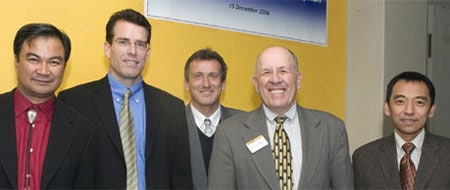Agilent & University of California at Davis Celebrate New Technique to Analyze Breast Milk
|
|
January 29, 2007
On December 15 at the University of the California at Davis (UCD), Agilent and UCD researchers celebrated a new technique to determine the oligosaccharide (OG) composition of human breast milk. Their technique was recently published in the online version of the Journal of Agricultural and Food Chemistry. Breast milk has long been recognized as the ideal food for newborns, and OGs are its third most abundant component. Because OGs provide no direct nutrition to infants, researchers are very interested in their role. Many experts believe that OGs promote healthy brain and digestive system development and function. The challenge is that human milk is incredibly complex and therefore difficult to analyze. More than 200 OG’s have been identified, but until now there has been no easy way to measure them all in a single analysis. Problem-solving tools developed by scientists and engineers working together within Agilent Life Sciences and Chemical Analysis (LSCA) and Agilent Laboratories now pave the way to a better understanding of the role of OG’s in human development. Agilent and U.C. Davis Celebration The celebration was held at UCD’s Chemistry Annex building, where UCD’s glycan research occurs. During his welcome address, Barry Klein, UCD’s vice chancellor, Office of Research, spoke about the challenge of moving beyond science and technology development to facing what he termed “delicious”—that is, extremely complex, multidisciplinary—problems, underscoring the importance of the collaboration. Agilent co-author Rudi Grimm, worldwide proteomics and metabolomics market development manager with LSCA, added that collaborations with universities are key for Agilent’s future success. Agilent’s research leads and co-authors – Kevin Killeen, project manager, and Hongfeng Yin, chemist, in Microfluidics at Agilent Labs, along with Rudi Grimm – were recently interviewed about the collaboration and about the development of LSCA’s new “glycan chip,” which made the OG analyses possible.
The collaborators achieved remarkable results in an important, emerging field. Is that why you are celebrating? Rudi: The celebration goes far beyond great science. With the help of Agilent Labs, our products have solved a customer problem in a completely new and undeveloped application area -- glycan analysis. The term “glycan” refers to the carbohydrate (the OG) portion of a glycoprotein. A glycoprotein is a large molecule composed of a both a protein and a carbohydrate. Because glycans are complex sugar polymers, they are very large, often branched, molecules. The largest of these can be quite difficult to analyze. Glycans play many biological roles. For example, free glycans in human milk are known to have an impact on stimulating the infant immune system. It is also known that about 50 percent of all human proteins bind with glycans and that these compounds can serve as indicators – biomarkers – of important diseases. And, because all antibody drugs and about eighty percent of protein drugs are glycoproteins, their analyses are critical to the pharmaceutical market. Prior to the collaboration, no other technology was available to identify low-level glycans in complex mixtures such as human milk, with high throughput and sensitivity. Without a doubt, working with the UCD researchers who lead this field is certainly worth celebrating. Without UCD chemistry professor Carlo Lebrilla, Ph.D. and his team, we could not have solved this problem so quickly. Why is the work cause for celebration for Agilent Labs? Kevin: The success of the collaboration marks the culmination of technology that we have been working on for more than ten years. It is in an area where we did not foresee any market interest, but, with a slight modification of the separating power of the Labs-developed microfluidic high-performance liquid chromatography (HPLC) chip, we were able to achieve remarkable results in a new application. The original development goals of the chip -- ease of use, throughput and sensitivity -- are important to a broad range of customers. If we create more application-specific chips, then we can meet the needs of a broad and growing community of users and grow the market for our HPLC chip technology. It is very gratifying to see UCD benefiting from the power of a platform that our project team worked on for a very long time.
How did the collaboration begin? Rudi: Carlito Lebrilla and I were both invited to speak at the KHUPO International Proteomics Conference in Korea in 2004. He presented UCD’s glycan work, while I presented our latest results in protein analysis, using our HPLC-Chip/MS system. When I listened to his talk, I realized that Agilent could help UCD get a richer set of results much more rapidly. Carlito was very interested in the resolving power and throughput of Agilent’s system. What are the key elements and innovations that came together to enable this breakthrough work? Hongfeng: UCD's application knowledge in oligosaccharide analysis and their experience and know-how in sample processing are critical in driving this research. The Labs' key contribution is the HPLC-chip. With the automated chip packing system, which was initially developed at Labs with help from Agilent’s Waldbronn facility, we were able to pack the chip with specialized porous graphite carbon material. This is also the first time we paired the HPLC-chip with Agilent's new time-of-flight mass spectrometer (TOF MS) platform. The chemical separating power of the chip, combined with the sensitivity and accurate mass that the TOF MS provides, allowed UCD researchers to do what they simply couldn't do before. Another important element is LSCA's deconvolution and feature extraction software. This software helps UCD researchers visualize and identify hundreds of oligosaccharides that present in breast milk. Such software is especially critical in determining low-abundant and high-molecular-weight isomers.
Kevin: This is one of the most interesting parts of the story. Using LSCA’s software, Hongfeng processed UCD’s data and uncovered a rich set of compounds that stunned all of us participating in the collaboration. UCD had been looking at their data using a different mass spectral technique which allowed them to see only a few compounds at a time. At first we all didn’t quite believe the results – we thought we were seeing noise and artifacts. After Hongfeng worked further with the data to validate it, we all were convinced that we had revealed a tapestry of interesting chemical compounds, including the OGs. The multidisciplinary nature of the collaboration is also critical. The researchers at UCD are chemists. At Agilent Labs we have chemists like Hongfeng who translate the language of chemistry into customer requirements that engineers and software developers understand. And, a lot of multidisciplinary work went into creating the original HPLC chip. How does the UCD collaboration, or collaborations in general, foster innovation at Agilent? Kevin: Agilent Labs has to be externally referenced, and the best way to do this is to collaborate with outside groups that are state-of-the-art in their fields. This is how we get our technology adopted and gain greater awareness of the contributions that Agilent can make to our customers’ work and to the scientific community. Through collaboration, the project team learns what customers’ real problems are and what they really want. And, a high level of engagement with leading customers is always very satisfying for the project team. Rudi: Agilent Labs’ and LSCA’s ability to work together in this collaboration is key to fostering the innovation that will provide Agilent with a competitive advantage and ensure its business success. Labs’ role is to come up with innovative technologies and business ideas and to explore new markets. LSCA provides feedback about how Lab innovations can fit with LSCA’s strategies and goals.
What did you learn from the collaboration? Rudi: This collaboration reminds us that it’s possible to simultaneously do great science and develop new products. Our solution provides twice the information for half the cost and is far superior to anything else on the market in terms of ease-of-use and throughput. Anyone on the UCD team can use the system. Hongfeng: It's important to work with the right people, both within Agilent and with outside collaborators. The UCD team is recognized in the academic community as thought leaders, especially in the field of oligosaccharide analysis. It always seems "easy" to work with strong collaborators, as long as the work is partitioned such that each group can contribute their best. Kevin: The collaboration illustrates how Agilent’s innovations are often the result of providing a solution in one application area and then applying it to another. In this case, we leveraged a technology that, after its transfer to LSCA, was focused on protein and peptide analyses. Agilent Labs customized the chip and paired it with a new mass spectrometer, thereby growing the technology’s application space and market potential to the analysis of glycans. What is next? How are you going to build on this innovation? Rudi: The next step is to continue expanding the applicability and use of the HPLC-chip. We will continue to optimize the analytical method’s resolving power so that customers are able to study more complex glycans. Kevin: At the Labs we are working with LSCA on all of this. We will continue to work on application-specific chips. We can take the early lead in their development because of our project team’s flexibility and experience with the core technology. We will help LSCA with the development of new HPLC-chip features to enhance analytical throughput and to make it available on other Agilent MS platforms. Cynthia Smith Related InformationPress Release: Agilent Technologies Announces New Technique for Rapid Analysis of Key Breast Milk Component, Nov. 20, 2006 |

